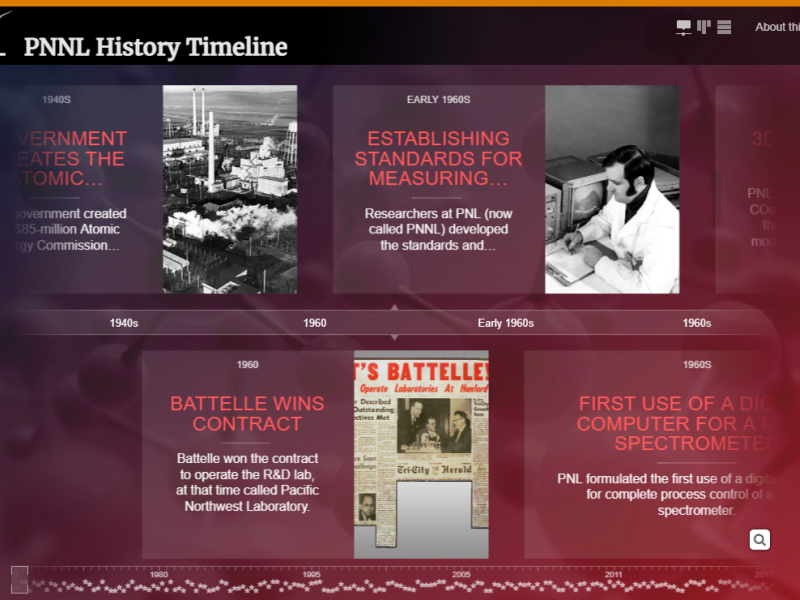Our History
Our History
Discovery and Impact:
Yesterday, Today and Tomorrow
Discovery and Impact:
Yesterday, Today and Tomorrow
For more than half a century, Pacific Northwest National Laboratory (PNNL) has been quietly contributing to a better, safer world. PNNL has always been a place where great minds tackle great challenges. Our researchers have developed numerous technologies, from the compact disc to ubiquitous airport security scanners, global climate models, and much more.
A Timeline of Our History
Discover our scientific achievements, technologies that have been transferred to industry—impacting national and global markets—campus expansion efforts, collaborations with industry and academia, and responses to national and world events.
Learn more about using/exploring the timeline below

Celebrating PNNL's 60th year
Since becoming a Department of Energy national lab in 1965, PNNL has established a legacy of advancing scientific discovery and technological innovation that delivers impactful outcomes to our region, nation, and world.
Looking forward, we are excited to continue advancing our understanding of the world around us and addressing some of our most pressing challenges in energy and national security.
At PNNL, WE are resolute in our commitment to advance scientific discovery and deliver technological innovation for energy and national security.
Moments in Time
Look back at significant moments in PNNL's history as we reflect on 60 years of discovery and impact.
Current Highlight: Studies aim to protect astronauts and propel spacecraft (1981)
PNNL developed instruments used to protect astronauts flying on the International Space Station. Since then, we’ve used our physics capabilities to investigate nuclear sources for space power and heat. Our long-standing partnership NASA continues today.
Our biologists recently sent soil to space to discover how microbial communities function, and PNNL researchers are comparing photosynthesis of plants in space to those on Earth.
Read the 1981 press release discussing the space radiation dosimeter developed by PNNL
Learn about recent PNNL research sending Washington soil to space
How to Use the Interactive Timeline


The interactive timeline is optimized for viewing on desktop/laptop computers but is also usable on mobile devices.
- Scroll through the horizontal timeline by using one of the following methods: use the scrollwheel, right-click and drag with your mouse, or swipe left or right on touchscreen devices.
- Click or tap on an event card to see more detail and access additional links, images, and media.
- Click or tap on a star along the bottom of the timeline to jump to a specific decade or view a particular highlight.
Mobile-friendly/Accessible View
An alternative list view is available below the main timeline, which may be preferable for mobile users or those who rely on adaptive tools and settings to browse the web.
Jump to the mobile-friendly/accessible view of the PNNL history timeline
